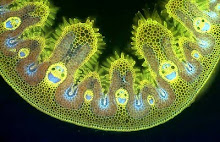This strange mutant of the greater plantain Plantago major has been documented for over 400 years. It's commonly known as the rose plantain and at first sight the flower bears little relation to....
... the flower spike of the normal wild-type plant. Greater plantain could be described as one of the dullest flowering plants in the British flora, but the 'rose' mutant is really something rather extraordinary.
Mutants like this were described and depicted in John Gerard's Herball or General Historie of Plants, published in 1597, and have been grown as curiosities in gardens ever since.
Four hundred years after the woodcuts of mutant greater plantains appeared in Gerard's Herball you can still buy seeds of similar plants.
The normal inflorescence of greater plantain looks like a green rat's tail and to appreciate it's relationship with this green rose-like structure you first need to look at the mutant inflorescence in side view, when.....
... you can see that it's composed of a spiral whorl of spoon-shaped bracts. If you compare these with .....
... the individual flowers of a short section of the spike of the wild-type plant you'll see that the latter has a tiny green leafy bract under each individual flower. All that has happened in the mutant is that the tiny bract has just kept on growing, until it has produced a large green petal-like structure under each flower. The other effect of the mutant has been to stop the elongation of the inflorescence spike, so the longitudinal axis has been telescoped, producing a rose-like inflorescence.
If you look at the basal green 'petals' of the rose mutant you can see the other floral parts - the ovary (beginning to swell) and the withered stigma and stamens - sitting there at its base, just as they do in the wild-type.
Here I've cut the whole mutant inflorescence vertically in half so you can see the compressed longitudinal axis. If these green enlarged bracts were brightly coloured you'd be looking at a rather attractive inflorescence!
Looking a little closer still, here you can see an ovary (that will become the seed capsule) at the base of each leafy bract and brown, withered stamens. Normally greater plantain is wind pollinated but it's almost impossible for pollen to escape from between those large green bracts, so the individual flowers always self-pollinate - which is why this mutant, first mentioned in Gerard's Herball four centuries ago, has bred true every since, has survived unchanged as a garden cultivar and can be reliably raised from a packet of seeds. If this mutant had been able to cross pollinate with the wild type it would be a rare occurrence, turning up sporadically in large populations of the plant.
So, apart from being a botanical curiosity, what else can this mutant tell us about the formation of flowers? Well, it shows how a simple mutation, that allows the bract growth process to go on for longer than normal but turns off the inflorescence elongation process too soon, can have a spectacular effect on the final appearance of a flower and its structures. It demonstrates that a small shift in the timing of developmental events can have a dramatic final outcome, making simple structures more complex (or vice-versa, because it can operate in the reverse direction too). It illustrates how such changes in the development of various components of the flower could have led to the evolution of great variety of flower forms we see today. These days plant scientists studying the genes that produce a flower create artificial mutants of the experimental plant thale cress Arabidopsis thaliana to work out which genes affect the development of each component of the flower and how they interact with one another to produce its final structure. This 400 year-old mutant, known to John Gerard (who was a noted plagiarist and most probably copied the information from earlier herbalists), gives us another insight into that process.























